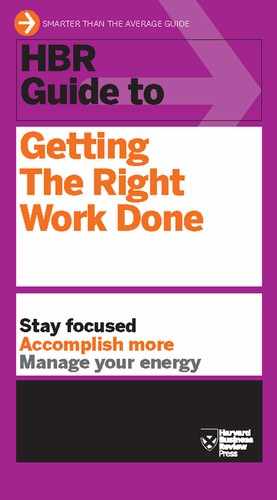Chapter 21
How to Accomplish More by Doing Less
by Tony Schwartz
We know that it’s not just the number of hours we sit at our desks that determines the value we generate. It’s the energy and focus we bring to those hours. Human beings are designed to pulse rhythmically between spending and renewing energy. That’s how we operate at our best. Maintaining a steady reservoir of energy—physically, mentally, emotionally, and even spiritually—requires refueling intermittently.
Take for example, two people of equal skill—Bill and Nick—who work in the same office. Each day they arrive at work at 9:00 AM and leave at 7:00 PM.
Bill works for 10 hours—essentially without stopping—juggling tasks at his desk and running between meetings all day long. He even eats lunch at his desk. By 1:00 PM, Bill’s feeling tired and beginning to lose focus. Between 4:00 and 7:00 PM, he’s really dragging and easily distracted.
It’s the law of diminishing returns. Because he doesn’t take breaks to renew his energy, Bill effectively delivers about 6 hours of productive work over his 10-hour day—about 60% of his capacity.
Now contrast that with Nick. He puts in the same 10 hours as Bill. But rather than working essentially without stopping, Nick paces himself: he works intensely for approximately 90 minutes at a stretch, and then takes a 15-minute break before resuming work. At 12:15, he goes out for lunch for 45 minutes or works out in a nearby gym. At 3:00 PM, he goes out to his car and takes a brief rest. Sometimes it turns into a 15- or 20-minute nap. Finally, between 4:30 and 5:00, he takes a 15-minute walk outside.
Nick takes off a total of two hours during his 10 at work, so he “only” puts in 8 hours. But because he’s building in periods of renewal with scheduled breaks, he’s able to work at 80% percent of his full capacity over the course of the whole day—20% more than Bill.
Cycling through periods of work and rest allows Nick to be more focused and alert than Bill, to make fewer mistakes, and to return home at night with more energy left for his family.
Work the way Nick does, and you’ll get more done, in less time, at a higher level of quality, more sustainably. Learn how to manage your energy, not your time, in the next article.
____________
Tony Schwartz is the president and CEO of The Energy Project and the author of Be Excellent at Anything. Become a fan of The Energy Project on Facebook and connect with Tony on Twitter at @tonyschwartz and @energy_project.
______________
Adapted from content posted on hbr.org on December 13, 2011.
